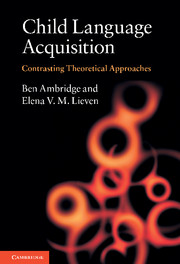Book contents
- Frontmatter
- Contents
- List of figures
- List of tables
- List of boxes
- List of summary tables
- Preface
- Acknowledgements
- 1 Introduction
- 2 Speech perception, segmentation and production
- 3 Learning word meanings
- 4 Theoretical approaches to grammar acquisition
- 5 Inflection
- 6 Simple syntax
- 7 Movement and complex syntax
- 8 Binding, quantification and control
- 9 Related debates and conclusions
- Notes
- References
- Author index
- Subject index
4 - Theoretical approaches to grammar acquisition
Published online by Cambridge University Press: 05 June 2012
- Frontmatter
- Contents
- List of figures
- List of tables
- List of boxes
- List of summary tables
- Preface
- Acknowledgements
- 1 Introduction
- 2 Speech perception, segmentation and production
- 3 Learning word meanings
- 4 Theoretical approaches to grammar acquisition
- 5 Inflection
- 6 Simple syntax
- 7 Movement and complex syntax
- 8 Binding, quantification and control
- 9 Related debates and conclusions
- Notes
- References
- Author index
- Subject index
Summary
The defining characteristic of human language is that it allows speakers to produce entirely new utterances (i.e. utterances that the speaker has never heard in precisely that form). Clearly in order to do so, speakers must be in possession of a grammar: a set of some kind of abstract ‘rules’ or ‘schemas’ used for combining words into sentences (syntax) and adding markers to words to express features such as tense (morphology). Two central questions in child language acquisition research are therefore: (1) what does this grammar look like? (i.e. what is the nature of the underlying system)? and (2) where does it come from (i.e. how is it acquired)? In this chapter, we outline two competing answers to the first question – the theoretical accounts of the adult endstate assumed by the generativist and constructivist approach respectively – and the implications of these accounts with regard to the second question. Although, in principle, one could imagine a non-nativist generativist account, all the actual generativist accounts that will be discussed in this chapter (and the remainder of the book) assume that at least some linguistic categories and principles regarding utterance formation are innate (i.e. present from birth). Constructivist accounts assume that whilst the potential to acquire language is of course innate, children are not born with innate knowledge of grammatical categories or principles, and construct their grammars on the basis of the input to which they are exposed.
- Type
- Chapter
- Information
- Child Language AcquisitionContrasting Theoretical Approaches, pp. 103 - 136Publisher: Cambridge University PressPrint publication year: 2011

